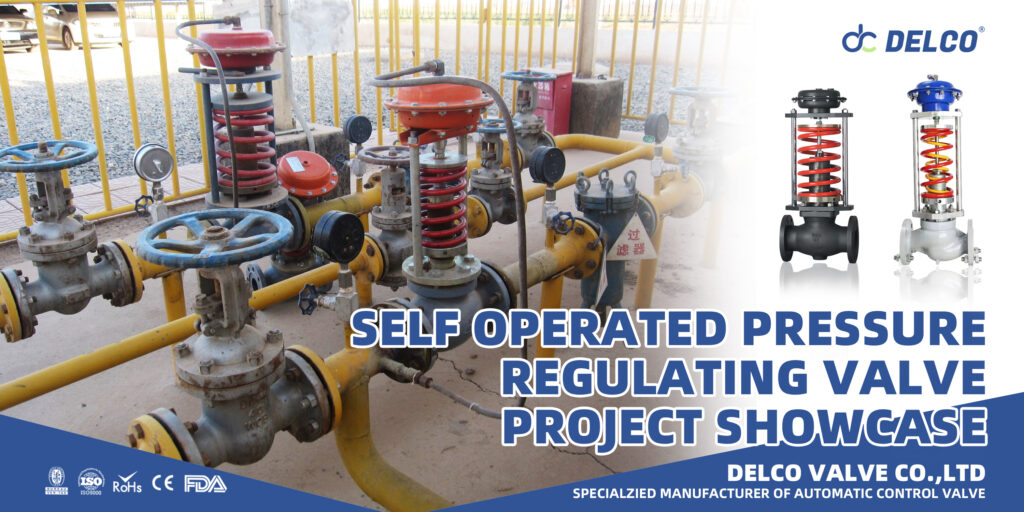แท็ก
ติดต่อเรา
Self-operated pressure regulating valve function
- วาล์วเดลโก้
Self-operated pressure regulating valves are critical control devices in various fluid systems, designed to automatically maintain a predetermined pressure level without the need for external energy sources. These instruments function as energy-efficient solutions by integrating control and execution mechanisms, essentially operating as independent instrument control systems that combine the functionalities of a transmitter, controller, and actuator. Unlike conventional control valves that require external power and control signals, these valves rely solely on the pressure signal of the medium being regulated to achieve the desired pressure control. Their ability to function autonomously makes them particularly advantageous in remote or power-constrained environments where the availability of electricity or compressed air might be limited. This self-sufficiency simplifies system design and reduces the complexities associated with external control infrastructure. These valves are also commonly referred to as self-acting control valves or self-operated pressure regulators.
Understanding DELCO Self-operated pressure regulating valves
DELCO Self-operated pressure regulating valves The fundamental principle behind the operation of self-operated pressure regulating valves lies in their autonomous ability to regulate pressure using the energy of the fluid flowing through them to actuate the valve mechanism. This self-regulation is achieved through an inherent feedback loop. The process begins with pressure sensing, where an integrated pressure-sensing component, such as a diaphragm, piston, bellows, or sensor, continuously monitors the pressure within the system. In some designs, a pitot tube facilitates the access of process fluid to pressurize a diaphragm. When the system’s pressure deviates from the desired level, this change is detected by the sensing device and communicated to the valve’s actuator. The actuator then responds by adjusting the valve’s opening or closing position. If the pressure exceeds the setpoint, the actuator reduces the valve’s opening to decrease the pressure. Conversely, if the pressure drops below the setpoint, the actuator increases the valve’s opening to raise the pressure. This adjustment often involves a balance of forces, where the pressure of the medium acting on the sensing element is counteracted by a load element, typically a spring. The pre-compression of this spring determines the desired pressure level, offering a straightforward method for users to configure the valve. The valve continuously modulates its position to maintain the preset pressure, ensuring stable and reliable pressure control within the system. In direct-acting valves, the upstream pressure is reduced to the downstream pressure through the throttling action of the valve core and seat. The downstream pressure is then fed into a chamber acting on a diaphragm or bellows, where the resulting force is balanced against the force of a spring, thereby positioning the valve to control the downstream pressure. This direct interaction between the downstream pressure and the valve’s closing force forms an intrinsic self-correcting mechanism that constantly works to maintain the set pressure.
Benefits of DELCO Self-operated pressure regulating valves
Reliability: DELCO solenoid valves are known for their durability and reliability, ensuring consistent performance even in demanding water treatment environments.
Efficiency: The efficient operation of DELCO solenoid valves helps in optimizing water treatment processes, leading to cost savings and improved productivity.
Versatility: These valves are available in a range of sizes and configurations, making them suitable for various water treatment applications, from filtration to disinfection.
Self-operated pressure regulating valve function
Self-operated pressure regulating valves can be categorized based on their control function and their operating mechanism. Based on their control function, they are primarily divided into self-operated downstream (pressure reduction) control valves and self-operated upstream (pressure relief) control valves. Self-operated downstream control valves, also known as pressure reducing valves or pressure regulators, are designed to maintain a constant pressure on the downstream side of the valve (outlet pressure), irrespective of fluctuations in the upstream pressure or the flow rate through the valve. These valves are essential for protecting downstream equipment that may have lower pressure ratings. For downstream pressure adjustment, the typical ratio between the upstream and downstream pressure ranges from 10:1 to 10:8. However, this limitation suggests that for applications requiring a significant pressure drop, a single-stage valve might not be sufficient, potentially necessitating a multi-stage reduction system. Self-operated upstream control valves, also known as pressure relieving regulators or back pressure regulating valves, are used to control the pressure on the upstream side of the valve (inlet pressure). They maintain the inlet pressure at a desired setpoint by opening proportionally when the inlet pressure rises above this setpoint. These valves serve as a crucial safety mechanism to prevent over-pressurization within a system. Unlike conventional safety relief valves that fully open to vent excess pressure, upstream pressure control valves offer continuous proportional control, allowing for a more controlled and gradual release of excess pressure, which can minimize system disturbances.


